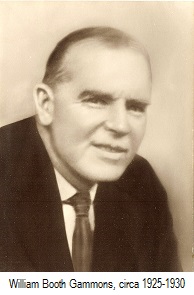
REPRINTS

 In 1886, at 14, William Gammons apprenticed himself to Francis H. Richards of 253 Main St., Hartford.�This is
significant because he did not receive the routine training of an ordinary machinist apprentice there.�Richards
was a "Solicitor of Patents" whose main business was to make full scale working models for any inventor who
lacked adequate facilities for executing his idea. This meant that Will Gammons was working to execute new ideas
and build machines at an early age.� This training got him employment as a full-fledged machinist at Dwight
Slate Machinery Company of Hartford in 1889.� Later he worked at Pratt & Whitney and the Fenn Manufacturing Co.
In 1886, at 14, William Gammons apprenticed himself to Francis H. Richards of 253 Main St., Hartford.�This is
significant because he did not receive the routine training of an ordinary machinist apprentice there.�Richards
was a "Solicitor of Patents" whose main business was to make full scale working models for any inventor who
lacked adequate facilities for executing his idea. This meant that Will Gammons was working to execute new ideas
and build machines at an early age.� This training got him employment as a full-fledged machinist at Dwight
Slate Machinery Company of Hartford in 1889.� Later he worked at Pratt & Whitney and the Fenn Manufacturing Co.
At some point while a young man, he also worked for Colt's Patent Firearms Manufacturing Co. While working at
Colt's, the company wanted to present something significant to visiting foreign dignitaries, so Will Gammons was
asked to make "nutmegs", carving them from wood saved from the historic old Charter Oak. �
Mr. Gammons became a respected inventor in his day.�Among other things, he invented the intermittent alarm
clock, an automatic money changing machine, and in 1917 he perfected the
Gammons (Helical) Taper Pin Reamer.�The latter became the principal product of the Gammons-Holman Company (est. 1920) of which he was
the founder and president.� This was the first invention for which he owned the patent.�Later inventions included
the
Parob Reamer, the
Gammons Expansion Reamer, and a
Broaching machine.�
Mr. Gammons started the manufacture of the helical reamer in the old Peter Adams mill in 1918. In 1920 the
Gammons-Holman Co. was formed with W.B. Gammons, Charles W. Holman, and H.O. Bowers as incorporators. In 1926,
as an individual, W.B. Gammons purchased an old Cheney mill at 395-405 Main St. and rented it to the
Gammons-Holman Co.
Mr. Gammons was a foreman at Pratt & Whitney when he invented the helical reamer. He offered the tool to
P&W for a block of Niles, Bement & Pond stock, stating that if they did not accept his offer he would then
manufacture it himself. The N-B-P directors met in Hartford (where P&W was a subsidiary), heard his offer, and
had the tool demonstrated. They adjourned to consider the proposal but subsequently rejected the plan as being
too revolutionary, saying it would require costly development. One of the directors then took Mr. Gammons aside
and said they wanted him to succeed so they would instruct him in proper administrative procedures for a
business � which they did.
At this point, William and Susannah Gammons sold their house and, with their life savings plus that of two
of Susannah's sisters, ordered the necessary machinery which Will Gammons designed himself. Once installed, one
hired toolmaker and Susannah Gammons initially kept the machines operating long hours each day while Will Gammons
visited potential customers and demonstrated the use of the tool.
Over time the helical reamer was used both nationally and internationally, although not applicable to other
businesses in Manchester. Two full shifts were necessary during World War II. Employees were highly skilled
craftsmen and women, some of whom worked for Gammons most of their lives. Each received a quarterly check, in
addition to their regular salary, which represented the profit sharing scheme which the Gammons family
considered fair and honest recompense for their loyalty and labor.
Mr. Gammons died in 1932 and, in 1933 his wife, Susannah Long Gammons, purchased Mr. Holman's minority
holding. She became president of the company and her daughter, general manger. They re-organized with C. Arthur
Hoaglund, a small tool engineer who had worked with Mr. Gammons, entering the corporation in 1940. Susannah
Gammons died in 1940 and her daughter, Marion Booth Gammons, became president until the company was sold in 1966.
William Booth Gammons, b. 17 May 1872 at South Norwalk, CT; d. 3 Oct 1932 at Manchester.�Married
Susannah Long 27 Sep 1897 in Manchester. (Buried with his wife and daughter, Marion Booth Gammons, in East
Cemetery, Manchester.)
Webmaster's Notes:
• This article was submitted by Marion Fitch Connell, granddaughter of William Booth Gammons and
Susannah Long Gammons.
• An ad for the reamers described above can be found in the 1927 Manchester Directory, which is on this web
site, by clicking